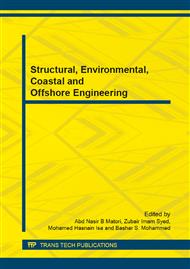[1]
Agrawal. A. W., Schlossberg. M. and Irvin. K. (2008). How Far, by Which Route and Why? A Spatial Analysis of Pedestrian Preference. Journal of Urban Design, Vol 13. No 1.
DOI: 10.1080/13574800701804074
Google Scholar
[2]
Tipakornkiat C., Limanond T. and Kim H. (2012). Determining and Influencing Area Affecting Walking Speed on Footpath: A Case Study of a Footpath in CBD Bangkok, Thailand. Physica A 391 (2012) 5453-5464.
DOI: 10.1016/j.physa.2012.06.001
Google Scholar
[3]
IISD. (2012). What is Sustainable Development?, Retrieved 29/11/12 from http: /www. iisd. org/sd.
Google Scholar
[4]
Campanella, M. C., Hoogendoorn, S. P. and Daamen, W. (2011). A methodology to Calibrate Pedestrian Walker Models Using Multiple-Objectives. New York: Springer (pp.755-759).
DOI: 10.1007/978-1-4419-9725-8_69
Google Scholar
[5]
Teknomo, K. (2002). Microscopic Pedestrian Flow Characteristics: Development of an Image Processing Data Collection and Simulation Model. Graduate School of Information Sciences, Tohoku University, Japan.
Google Scholar
[6]
Daamen, W. and Hoogendoorn, S.P. (2012). Calibration of Pedestrian Simulation Model for Emergency Doors for Different Pedestrian Types. TRB Annual Meeting Technical Papers (pp.1-12). Washington DC Transportation Research Board.
DOI: 10.3141/2316-08
Google Scholar
[7]
Campanella, M. C., Hoogendoorn, S. P. and Dameen, W. (2011). Calibrating Walker Models: Variations of Parameter Due to Traffic Regimes. European Conference on Mathematical and Theoretical Biology.
Google Scholar
[8]
Hongfei, J., Lili, Y. and Ming, T. (2009). Pedestrian Flow Characteristic Analysis and Model Parameter Calibration in Comprehensive Transport Terminal. J Transpn Sys Eng & IT, 9(5), 117-123.
Google Scholar
[9]
PED. (2012). 6th International Conference on Pedestrian and Evacuation Dynamics Retrieved 30/11/12, from http: /www. ped2012. org.
Google Scholar
[10]
Daamen, W. and Hoogendoorn, S.P. (2003). Research on PedestrianTraffic Flows in Netherlands. Procceding Walk 21 IV (pp.101-117). Portland, Oregon, United States.
Google Scholar
[11]
O'Sullivan. S. and Morral. J. (1996). Walking Distance to and from Light Rail Transit System. Transportation Research Recod (TRR) Journal-1538.
Google Scholar
[12]
Schadschneider, A., Klingsch, W., Klüpfel, H., Kretz, T., Rogsch, C., & Seyfried, A. (2008). Evacuation Dynamics: Empirical Results, Modeling and Applications.
DOI: 10.1007/978-1-4419-7695-6_29
Google Scholar
[13]
Oxley J., Fildes B., Ihsen E., Charlton J., and Day R., (1997). Differences in Traffic Judgements Between Young and Old Adult Pedestrians. Accident Analysis and Prevention, Volume 29, No. 6, p.839 – 847.
DOI: 10.1016/s0001-4575(97)00053-5
Google Scholar
[14]
Xu, S. and Duh, H. B. L. (2010). A Simulation of Bonding Effect and Their Impacts on Pedestrian Dynamics. IEEE Transaction on Intelligent Transportation Systems. Vol 11. No 1.
Google Scholar
[15]
National Land Public Transport Masterplan Final Draft (2012). Suruhanjaya Pengangkutan Awam Darat (SPAD) Malaysia.
Google Scholar
[16]
Cheng H. and Yang X., (2012). Emergency Evacuation Capacity of Subways Station. Social and Behavioral Sciences 43 (2012) 339 – 348.
DOI: 10.1016/j.sbspro.2012.04.107
Google Scholar
[17]
Lei W., Li A., Gao R., Hao X. and Deng B., (2012). Simulation of Pedestrian Crowds' Evacuation in a Huge Transit Terminal Subway Station. Physica A 391 (2012) 5355 – 5365.
DOI: 10.1016/j.physa.2012.06.033
Google Scholar
[18]
Davidich, M and Koster, G. (2012). Towards Automatic and Robust Adjustment of Human Behavioral Parameters in a Pedestrian Stream Model to Measured Data. Safety Science. Volume 50 (2012). Pp 1253-1260.
DOI: 10.1016/j.ssci.2011.12.024
Google Scholar
[19]
Helbing, D. and Molnar, P. (1995). Social Force Model for Pedestrian Dynamics. Physical Review E. Volume 51, No. 5, p.4282 – 4286.
DOI: 10.1103/physreve.51.4282
Google Scholar
[20]
Bauer, D., Seer, S. and Brandle, N. (2007). Macroscopic Pedestrian Flow Simulation for Designing Crowd Control Measures in Public Transport After Special Events. Summer Computer Simulation Conference (SCSC). ISBN 1-56555-316-0.
Google Scholar
[21]
Qi, Z. and Baoming, H. (2011). Simulation Model of Pedestrian Interactive Behavior. Physica A 390 (2011) 636 – 646.
Google Scholar
[22]
Shiwakoti, N., Sarvi, M. and Rose, G. (2008). Modeling Pedestrian Behavior Under Emergency Conditions – State of the Art and Future Directions. 31st Australasian Transport Research Forum. Pp 457-473.
Google Scholar
[23]
Zainuddin, Z., Thinakaran, K., & Abu-Sulyman, I. M. (2009). Simulating the Circumambulation of the Ka'aba using SimWalk. © EuroJournals Publishing, Inc. 2009, Vol. 38 No. 3 (2009), pp.454-464.
Google Scholar
[24]
Sahaleh, A.S., Bierlaire, M., Farooq, B., Danalet, A., Hänseler, F.S. (2012). Scenario Analysis of Pedestrian Flow in Public. STRC (2012).
Google Scholar
[25]
Hoogendoorn, S. P., Daamen, W. and Bovy, P. H. L. (2003). Extracting Microscopic Pedestrian Characteristic from Video Data. TRB Annual Meeting.
Google Scholar
[26]
Johansson, A., Helbing, D., Al-Abideen, H. Z., and Al-Bosta, S. (2008). From Crowd Dynamics to Crowd Safety. World Scientific Publishing Company (WPSC).
DOI: 10.1142/s0219525908001854
Google Scholar
[27]
Davies, A. C., Yin, J. H. and Velastin, S. A. (1995). Crowd Monitoring Using Image Processing. IEE Electronic and Communications Engineering Journal. Vol 7. No 1. pp.37-47.
DOI: 10.1049/ecej:19950106
Google Scholar
[28]
Lam, W. H. K. and Cheung, C. Y. (2000). Pedestrian Speed/Flow Relationships for Walking Facilities in Hong Kong. Journal Transportation Engineering. 126: 343-349.
DOI: 10.1061/(asce)0733-947x(2000)126:4(343)
Google Scholar


